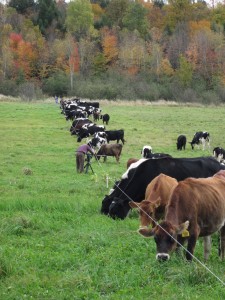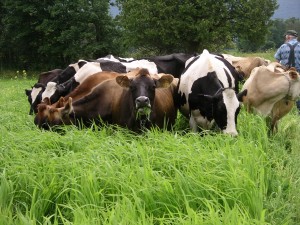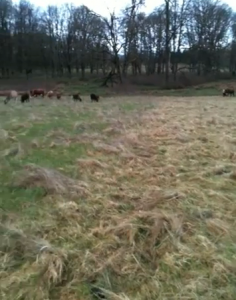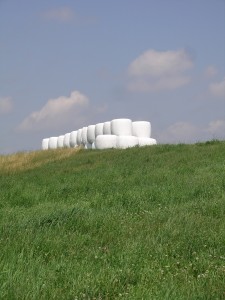By: Juan P. Alvez | Pasture Technical Coordinator
UVM Center for Sustainable Agriculture
Farming requires mental and physical involvement in the complex management of the soil, plants, animals, people, equipment, weather and markets. While this complexity is constantly changing, problems can sometimes become opportunities. Then, anything livestock producers can do to keep animals rotationally grazing for as long as possible, will return lower costs and higher benefits in general. Exceptions should be made during extreme cold and wind, of course.
A common challenge when trying to extend the grazing season is that, in northeastern United States, grazing does not last the entire year, but it can be extended if carefully planned.
Generally, it is safe to assume that we can count on a grazing season that goes from April until September (though grazing through October or early November may be possible, depending upon a grazing plan (see Troy Bishop’s grazing charts and planning resources), well-managed pastures, and the use of annual forage supplementation before feeding hay bales. ‘Well-managed’ means, rationally rotating high stock density through small paddock areas, for periods not exceeding 2 or 3 days, leaving these resting behind with about 4 inches of trampled forage residue.
Pasture is dynamic. While extending the grazing season and increasing productivity and net profits are common challenges, a recommended approach (other than encouraging as many forage-adapted species as possible), is to manage the sward dynamically and with flexibility because, pasture farming is dynamic. This flexible management must also be observed with the animals.
For example, strategically promoting long rest periods in some areas of the farm at times, may encourage natural seeding, root development, soil health and habitat for beneficial fauna. Or, heavily grazing down other areas of the farm may advantageously help re-balance forage species. Stockpiled forage for later winter grazing in fallowed areas or winter “bale grazing” must also be used with flexibility.
It is important to match forage quality and intake to animal needs because, certain animals that require higher nutritional demands must graze the best relative forage quality. For example, milking or breeding cows have different nutrient demands than dry animal or heifers thus, milking or breeding cows must receive the best pastures.
Moreover, a sustained production, will depend on full time dedication and constant access to reliable information. For this and other reasons, grazers must walk their pastures, observe their animals, take notesand if possible pictures.
Suggested Strategies for Extending the Grazing Season
- April to September: Graze most of the pastures normally;
- June: Between the first and second hay cut, reserve a few paddocks for seeding warm season annual species to be grazed late in the summer when is dry. This bulk production can last through the end of August (high yields may need fertilization), providing one or two cuts or grazings;
- August: Defer a few paddocks for winter, stockpiling forages by fencing animals out;
- September: 3 weeks before the killing frost, seed winter annuals; the area left by the warm season species could be an option to use. Winter annual forages can extend the season another 30 or 60 days.
- Strip-graze the stockpiled forages deferred in August; when finished, feed the hay bales harvested until the next Spring.
Have you explored different ideas to extend your grazing season? If you want to share them, drop us a line at the UVM Pasture Program:
Jennifer Colby (jcolby@uvm.edu)
Juan Alvez (jalvez@uvm.edu) and,
Kimberly Hagen (kimberly.hagen@uvm.edu)






[…] successful forage ideas to overcome the summer slump and have a more uniform livestock production along the season? You can share your observations in the comments below or by dropping Juan a line […]
[…] Baby It’s Cold Outside! Watch Out For Livestock « On Pasture on Pasture Management: Extending the Grazing Season […]
[…] animals can bear cold weather. But even if we want to extend the grazing season, keeping our animals outside as much as possible, there are some kinds of cold weather that we […]
[…] » Pasture management: perennial or annual forages? : VT Pasture Network : University of Vermont on Pasture Management: Extending the Grazing Season […]
[…] » Pasture management: perennial or annual forages? : VT Pasture Network : University of Vermont on Pasture Management: Extending the Grazing Season […]
[…] An ideal forage pasture sward should include three main categories: grasses, legumes, and forbs. In general, legumes provide proteins, (which are the building blocks for animal growth), and increase total digestible nutrients (TDN). Grasses mostly deliver energy via carbohydrates (sugars). Forbs (some known as weeds), provide vitamins and vital compounds. Be careful with poisonous plants animals might not be aware. Establishing forage species can be as simple as broadcasting them in a pasture strip (by hand or with machinery) just before animals are to be moved to a new strip or pasture. That way, animals can briefly walk around the strip or paddock to promote seed-soil contact and stimulate better germination. Remember that legumes need some special preparation (i.e.: inoculation) for maximum benefit (see next post, and check this factsheet). Annual or biennial forage species can provide feed supplementation for grazing animals in times when some perennial pastures decline production. A practice that can be adopted is deferring or reserving sections of perennial pastures for later in the season and take advantage of the bulk energy and nutrition provided by annual forage species. In general, in the Northeast, annuals are best provided during mid to late-Summer, to help overcome dry spells and during Fall, to extend the grazing season (see previous post). […]